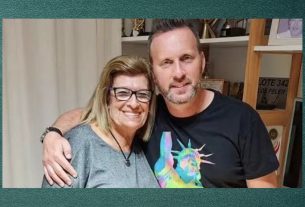(JR) — I regularly post Middle Eastern Jewish feminist content on social media, so right when Mahsa Amini was murdered, TikTok’s algorithm flooded my account with videos of women from Iran, giving a play-by-play account of events.
Amini was a 22-year-old woman from Kurdistan, visiting her relatives in Tehran. Despite the fact that she was covered from head to toe, wearing the compulsory hijab, the “morality police” arrested and beat her to death because they did not approve of how she was dressed. That incident was Iran’s equivalent of George Floyd’s murder in the United States, and sparked a woman-led revolution throughout Iran and Kurdistan — with protesters flooding the streets, women publicly burning their hijabs, and police arresting tens of thousands of protesters, as well as brutally torturing and murdering hundreds. The incident shook me to my core and felt very personal to me, specifically as a Jew.
The degree to which the murder of a Muslim woman in Tehran affected a Jewish woman in Seattle might surprise many in the American Jewish community. To understand, let’s take a little trip back through time: Jews throughout the Middle East and North Africa hail from the Babylonian conquest of ancient Israel, Yehuda, which is how we got our name, Yehudim, or Jews. Fifty years after that conquest, the Persian empire conquered the Babylonian empire and not only allowed the Jews to go home, but helped rebuild the Temple — the wall still remaining today in Jerusalem. Many Jews nonetheless stayed put or migrated throughout the Asian and African continents — including my family, who remained on the land of Babylon until being exiled from Iraq in 1950. We are collectively known as the Mizrahim.
Contrary to popular belief, Arab Muslims are not indigenous throughout the Middle East and North Africa; rather, they rose up from the Arabian Peninsula and conquered the region, similar to the Christian crusaders of Europe. Many indigenous ethnicities and religions predated the Arab Muslim presence by well over a millennia — including Jews, Persians and Kurds. Still, all were subject to the whims of Muslim rule — including the injunction that all women, including Jewish women, had to wear the local variations of the hijab.
I inherited my grandmother’s abaya, a black silk head-to-toe garment that she wore in the blazing heat of Baghdad, day after day. In the introduction to first edition of my 2003 book, “The Flying Camel: Essays on Identity by Women of North African and Middle Eastern Jewish Heritage,” I talked about coming across this garment in the attic of my parents’ house in the Bay Area, where I grew up. After putting it on, I looked in the mirror — two brown eyes peering back at me, with my face and body otherwise shrouded in black.
How did my grandmother feel wearing it? I wondered. I will never know, because the stories of my family were filtered through my father, lacking the woman’s perspective.
When I first finished compiling and editing my anthology, 30 years ago, it was in fact called “Behind the Veil of Silence” — not only because of the theme of Middle Eastern and North African Jewish women physically wearing the veil, but also because of additionally being shrouded by a veil of obscurity in each of the communities to which we belong/don’t belong.
Case in point: Nobody wanted to publish the anthology for another decade — not the Jewish press, the people-of-color press, or the feminist press. I was told we needed to include Ashkenazi women, non-Jewish women of color, and even men, to make the book relevant or valid. Standing on principle and integrity, I insisted that we were relevant and valid in our own right, and over the years, could wallpaper my apartment with rejection letters.
Then 9/11 happened; consciousness shifted; I had several top literary agents fighting over the book; and ultimately, one of the many publishers I had approached years prior ended up publishing the book in 2003. By then, everyone was writing books about Middle Eastern women and veils, so I ended up having to change the title. The veil, however, remained and remains not only an apt metaphor for the invisibility of Middle Eastern and North African Jewish women, but also for our collective physical experience of donning the veil under Muslim rule.
Which all goes to say, the murder of Mahsa Amini, and the subsequent uprising in Iran, not only feel very personal to me, but are inextricably intertwined with Jewish identity and history. From this deeply personal and Jewish place, I wrote the poem “#MahsaAmini” just a day or two after Amini’s murder, and months later, I turned it into a song, incorporating the style of traditional Middle Eastern Jewish prayers. My band finished developing the song several weeks ago, just in time to release it on Saturday, the anniversary of Amini’s death.
On the day the song automatically begins streaming, I will be chanting the ancient Iraqi prayers for Rshana (Rosh Hashanah). Come to think of it, as the first woman worldwide that I know of to publicly lead Sephardi/Mizrahi prayers, starting back in the early 1990s, and having led the women’s section of an Iraqi synagogue in an uprising back in the 1980s, when I was just 14, the timing is perhaps a particularly fitting coincidence.
I recently let numerous Jewish media outlets know about the release, with little traction, and one responding that while it is “truly a powerful and important song…we don’t think there’s a clear enough Jewish component to cover.” Out of curiosity, I looked up articles on the Ukraine war in this very same outlet, and found numerous articles on the topic.
How is the Ukraine war more Jewish than the Iranian uprising? The difference is one of Ashkenazi perspective and frame of reference. Despite the strides of Jewish multiculturalism permeating mainstream Jewish consciousness; despite Persian Jewish history predating European Jewish history by as much as two millennia; and despite Mizrahim comprising between 50% and 70% of Israel’s Jewish population since the mid-20th century, “Iran” still does not equate with “Jewish,” whereas countries like Ukraine, Poland and Germany do.
It’s a vicious cycle: As Jewish institutes continue to fail entirely, or at least adequately, to teach about Jewish history and heritage from outside Central and Eastern Europe — despite ample opportunities and resources to do so — and as that which is Sephardi/Mizrahi and Ethiopian-Jewish continue to be treated as extracurricular and optional, contemporary issues significant for global Jewry will continue to seem entirely disconnected from Jewish relevance, and will be neither discussed nor taught, with the ignorance creating more ignorance.
The uprising raises so many decidedly Jewish questions: Where was the world’s outrage when Jews were being lynched publicly in Iran? How does the Persian Jewish community experience this new revolution? Can the older Iranians now recognize Jews as the canaries in the coal mine of the 1970s Iranian revolution?
Then there’s the fact that Jews are part of the revolutionary leadership in Iran. Take Armita Abbasi, a young woman whose name I deliberately speak in the #MahsaAmini song. After Abbasi led a demonstration, police arrested and gang-raped her repeatedly, otherwise tortured her, and barred her family from a hospital visit. Photos of Abbasi show her proudly wearing a Star of David necklace, and I imagine police were delighted by the two-for-one opportunity to destroy both a woman and a Jew.
The beauty of Jewish multicultural consciousness is that it inherently teaches there is no us/them. Jews are an integral part of the fabric of every society and culture around the world. We are the connecting thread, the bridge between the gaps of humanity. When we step into this consciousness, we can transmute divisive thinking that currently plagues our world. And perhaps then, we can truly serve as a light unto the nations.
has been a pioneering Jewish multicultural educator since 1990. She is the author of “The Flying Camel: Essays on Identity by Women of North African and Middle Eastern Jewish Heritage” and the singer, songwriter and bass player for Seattle band Iraqis in Pajamas.
The views and opinions expressed in this article are those of the author and do not necessarily reflect the views of JR or its parent company, 70 Faces Media.




